International Journal of Information Technology and Computer Science @ijitcs
Статьи журнала - International Journal of Information Technology and Computer Science
Все статьи: 1254
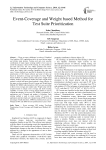
Event-Coverage and Weight based Method for Test Suite Prioritization
Статья научная
There are many challenges in testing of Graphical User Interface (GUI) applications due to its event driven nature and infinite input domain. Testing each and every possible combination of input require creating number of test cases to satisfy the adequacy criteria of GUI testing. It is not possible to test each and every test case within specified time frame. Therefore it is important to assign higher priority to test cases which have higher fault revealing capability than other test cases. Various methods are specified in literature for test suite prioritization of GUI based software and some of them are based on interaction coverage and weight of events. Weight based methods are defined namely fault prone weight based method, random weight based method and equal weight based method in which fault prone based method is most effective. In this paper we have proposed Event-Coverage and Weight based Method (EC-WBM) which prioritizes GUI test cases according to their event coverage and weight value. Weight value will be assigned based on unique event coverage and fault revealing capability of events. Event coverage based method is used to evaluate the adequacy of test cases. EC-WBM is evaluated for 2 applications one is Notepad and another is Calculator. Fault seeding method is used to create number of versions of application and these faults are evaluated using APFD (Average percentage of fault detection). APFD for prioritized test cases of Notepad is 98% and APFD for non-prioritized test cases is 62%.
Бесплатно
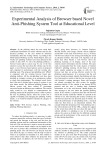
Experimental Analysis of Browser based Novel Anti-Phishing System Tool at Educational Level
Статья научная
In the phishing attack, the user sends their confidential information on mimic websites and face the financial problem, so the user should be informed immediately about the visiting website. According to the Third Quarter Phishing Activity Trends Report, there are 55,282 new phishing websites have been detected in the month of July 2014. To solve the phishing problem, a browser based add-on system may be one of the best solution to aware the user about the website type. In this paper, a novel browser based add-on system is proposed and compared its performance with the existing anti-phishing tools. The proposed anti-phishing tool 'ePhish' is compared with the existing browser based anti-phishing toolbars. All the anti-phishing tools have been installed in computer systems at an autonomous college to check their performance. The obtained result shows that if the task is divided into a group of systems, it can give better results. For different phishing features, the add-on system tool show around 97 percentage successful results at different case conditions. The current study would be very helpful to countermeasure the phishing attach and the proposed system is able to protect the user by phishing attacks. Since the system tool is capable of handling and managing the phishing website details, so it would be helpful to identify the category of the websites.
Бесплатно
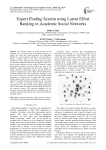
Expert Finding System using Latent Effort Ranking in Academic Social Networks
Статья научная
The dynamic nature of social network and the influence it has on the provision of immediate solutions to a simple task made their usage prominent and dependable. Whether it is a task of getting a solution to a trivial problem or buying a gadget online or any other task that involves collaborative effort, interacting with people across the globe, the immediate elucidation that comes into anyone’s mind is the social network. Question Answer systems, Feedback systems, Recommender systems, Reviewer Systems are some of the frequently needed applications that are used by people for taking a decision on performing a day to day task. Experts are needed to maintain such systems which will be helpful for the overall development of the web communities. Finding an expert who can do justice for a question involving multiple domain knowledge is a difficult task. This paper deal with an expert finding approach that involves extraction of expertise that is hidden in the profile documents and publications of a researcher who is a member of academic social network. Keywords extracted from an expert’s profile are correlated against index terms of the domain of expertise and the experts are ranked in the respective domains. This approach emphasizes on text mining to retrieve prominent keywords from publications of a researcher to identify his expertise and visualizes the result after statistical analysis.
Бесплатно
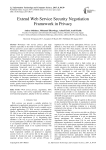
Extend Web Service Security Negotiation Framework in Privacy
Статья научная
Nowadays web service privacy gets high attention especially in the fields of finance and medical. Privacy preserves access rights to personally identifiable information. Different models have been proposed for enforcing privacy in web service environment. Getting a privacy level for protecting data transferred between consumer and provider in a web service environment is still a problem. Negotiation helps participants to get a privacy level. This paper extends web service security negotiation framework in a multilateral web service environment for negotiating privacy. A repaired genetic negotiation framework used to conduct the privacy negotiation. In privacy negotiation, the negotiation communication structure uses a broker for negotiation; where each participant sends its attributes to the broker. Negotiation using this communication structure decreases the number of messages transferred so less execution time. The genetic-based Negotiation is compared to traditional time-based negotiation. Through experimental results, genetic based negotiation outperforms traditional time-based negotiation.
Бесплатно
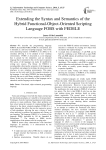
Статья научная
We describe the programming language FOBS-X (Extensible FOBS). FOBS-X is interpreted, and is intended as a universal scripting language. One of the more interesting features of FOBS-X is its ability to be extended, allowing it to be adopted to new scripting environments. FOBS-x is structured as a core language that is parsed by the interpreter, and an extended language that is translated to the core by macro expansion. The syntax of the language can easily be modified by writing new macros. The library for FOBS-X is reconfigurable, allowing the semantics of the language to be modified, and adapted to facilitate the interaction with interfaces to new scripting environments. This paper focuses on the tools used for the semantic extension of the language. A tool called FEDELE has been developed, allowing the user to add library modules to the FOBS-X library. In this way the semantics of the language can be enhanced, and the language can be adapted.
Бесплатно
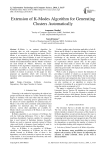
Extension of K-Modes Algorithm for Generating Clusters Automatically
Статья научная
K-Modes is an eminent algorithm for clustering data set with categorical attributes. This algorithm is famous for its simplicity and speed. The K-Modes is an extension of the K-Means algorithm for categorical data. Since K-Modes is used for categorical data so 'Simple Matching Dissimilarity' measure is used instead of Euclidean distance and the 'Modes' of clusters are used instead of 'Means'. However, one major limitation of this algorithm is dependency on prior input of number of clusters K, and sometimes it becomes practically impossible to correctly estimate the optimum number of clusters in advance. In this paper we have proposed an algorithm which will overcome this limitation while maintaining the simplicity of K-Modes algorithm.
Бесплатно
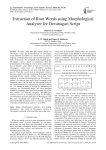
Extraction of Root Words using Morphological Analyzer for Devanagari Script
Статья научная
In India, more than 300 million people use Devanagari script for documentation. In Devanagari script, Marathi and Hindi are mainly used as primary language of Maharashtra state and national language of India respectively. As compared with English script, Devanagari script is reach of morphemes. Thus the lemmatization of Devanagari script is quite complex than that of English script. There is lack of resources for Devanagari script such as WordNet, ontology representation, parsing the keywords and their part of speech. Thus the overall task of information retrieval becomes complex and time consuming. Devanagari script document always carries suffixes which may cause problem in accurate information retrieval. We propose a method of extracting root words from Devanagari script document which can be used for information retrieval, text summarization, text categorization, ontology building etc. An attempt is made to design the Morphological Analyzer for Devanagari script. We have designed CORPUS containing more than 3000 possible stop words and suffixes for Marathi language. Morphological Analyzer can acts as a preliminary stage for developing any information retrieval application in Devanagari script. We have conducted the experiments on randomly selected Marathi documents and we found the accuracy of designed morphological analyzer is up to 96%.
Бесплатно
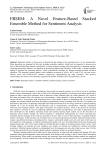
FBSEM: A Novel Feature-Based Stacked Ensemble Method for Sentiment Analysis
Статья научная
Sentiment analysis is the process of determining the attitude or the emotional state of a text automatically. Many algorithms are proposed for this task including ensemble methods, which have the potential to decrease error rates of the individual base learners considerably. In many machine learning tasks and especially in sentiment analysis, extracting informative features is as important as developing sophisticated classifiers. In this study, a stacked ensemble method is proposed for sentiment analysis, which systematically combines six feature extraction methods and three classifiers. The proposed method obtains cross-validation accuracies of 89.6%, 90.7% and 67.2% on large movie, Turkish movie and SemEval-2017 datasets, respectively, outperforming the other classifiers. The accuracy improvements are shown to be statistically significant at the 99% confidence level by performing a Z-test.
Бесплатно
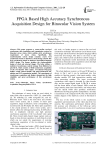
FPGA Based High Accuracy Synchronous Acquisition Design for Binocular Vision System
Статья научная
This paper proposes a coarse-to-fine two-level synchronous data acquisition and transmission system for binocular stereo vision, which satisfies strict synchronous requirement of stereo vision. Specifically, this synchronization system design contains: coarse level synchronous based on hardware circuit design and the fine level synchronous based on hardware description language (HDL) design. The former includes the synchronization design of clock and external trigger. The latter utilizes a multi-level synchronous control strategy from field-level to pixel-level, which consists of field-synchronous acquisition of the two-channel video inputs, two-channel Ping-pong buffers switch control module, and pixel-synchronous bit-splicing and PCI transmission module. The experiments of synchronous acquisition and display demonstrate the high reliability and great performance of this synchronous system.
Бесплатно

Статья научная
This paper presents, a high speed FPGA implementation of fully digital controller for three-phase Z-Source Inverter (ZSI) with two switching strategies include simple boost control and maximum boost control. In this method total of blocks are based on proposed digital circuits only with combinational logic and using pipelining technique. Since it is vital to have a high speed and effective ZSI controller, a novel digital design for pulse width modulation control have been implemented for simple and maximum boost control of the ZSI. The proposed digit controllers have been successfully synthesized and implemented by Quartus II 9.1V and Cyclone II FPGA, to target device EP2C20F484C6. Achieved result demonstrates that the proposed method has features including reconfigurable, low-cost, high speed and also it is very accurate.
Бесплатно
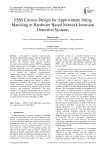
Статья научная
In this paper we present a logical circuits design for approximate content matching implemented as finite state machines (FSM). As network speed increases the software based network intrusion detection and prevention systems (NIDPS) are lagging behind requirements in throughput of so called deep package inspection - the most exhaustive process of finding a pattern in package payloads. Therefore, there is a demand for hardware implementation. Approximate content matching is a special case of content finding and variations detection used by "evasion" techniques. In this research we will enhance the k-differentiate problem with "ability" to detect a generalized Levensthein edit distance i.e. transposition of two neighboring characters. The proposed designs are based on automata theory using the concept of state reduction and complexity minimization. The main objective is to present the feasibility of the hardware design and the trade-off between the simple next state and output functions of NFA and reduced number of required memory elements (flip-flops) of DFA.
Бесплатно
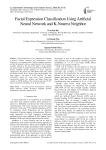
Facial Expression Classification Using Artificial Neural Network and K-Nearest Neighbor
Статья научная
Facial Expression is a key component in evaluating a person's feelings, intentions and characteristics. Facial Expression is an important part of human-computer interaction and has the potential to play an equal important role in human-computer interaction. The aim of this paper is bring together two areas in which are Artificial Neural Network (ANN) and K-Nearest Neighbor (K-NN) applying for facial expression classification. We propose the ANN_KNN model using ANN and K-NN classifier. ICA is used to extract facial features. The ratios feature is the input of K-NN classifier. We apply ANN_KNN model for seven basic facial expression classifications (anger, fear, surprise, sad, happy, disgust and neutral) on JAFEE database. The classifying precision 92.38% has been showed the feasibility of our proposal model.
Бесплатно
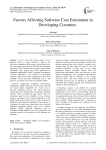
Factors Affecting Software Cost Estimation in Developing Countries
Статья научная
Cost is the main driving factor for all projects. When it is done correctly, it helps in the successful completion of the project. In this research we have discussed various factors that affect the estimation procedure. These include team structure, team culture, managerial style, project type (Core application or integrated application), client’s working environment. Accurate estimation is far difficult in developing countries where most of the organizations follow local standards. These inaccurate estimations lead to late delivery, less profit or in worst case complete failure. Software requirement gathering, development, maintenance, quality assurance and cost of poor quality are major groups responsible for overall cost in software production process. The exact proportion among them varies significantly in consecutive software releases, which is caused by many factors. The ever increasing need for the reliability of the software systems, especially mission critical applications in the public safety domain, raises the bar for the accuracy of prediction and estimation techniques. The accuracy of estimations in many areas brings about more concerns regarding techniques already used in the software industry. Widely deployed techniques, such as Wideband Delphi method, stress the engineering and technical aspects of the process of how estimates are prepared.
Бесплатно
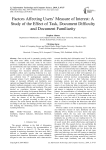
Статья научная
Data on the web is constantly growing which may affect users’ ability to find relevant information within a reasonable time limit. Some of the factors previously studied that affect users searching behaviour are task difficulty and topic familiarity. In this paper, we consider a set of implicit feedback parameters to investigate how document difficulty and document familiarity affects users searching behaviour in a task-specific context. An experiment was conducted and data was collected from 77 undergraduate students of Computer science. Users’ implicit features and explicit ratings of document difficulty and familiarity were captured and logged through a plugin in Firefox browser. Implicit feedback parameters were correlated with user ratings for document difficulty and familiarity. The result showed no correlation between implicit feedback parameters and the rating for document familiarity. There was, however, a negative correlation between user mouse activities and document difficulty ratings. Also, the dataset of all the participants in the experiment was grouped according to task type and analysed. The result showed that their behaviour varies according to task type. Our findings provide more insight into studying the moderating factors that affect user searching behaviour.
Бесплатно
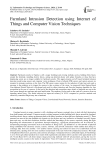
Farmland Intrusion Detection using Internet of Things and Computer Vision Techniques
Статья научная
Farmland security in Nigeria is still a major challenge and existing methods such as building brick fences around the farmland, installing electric fences, setting up deterrent plants with spikey branches or those that have displeasing scents are no longer suitable for farmland security. This paper presents an IoT based farmland intrusion detection model using sensors and computer vision techniques. Passive Infrared (PIR) sensors and camera sensors are mounted in strategic positions on the farm. The PIR sensor senses motion by the radiation of body heat and sends a message to the raspberry pi to trigger the camera to take a picture of the scene. An improved Faster Region Based Convolutional Neural Network is developed and used for object detection and One-shot learning algorithm for face recognition in the case of a person. At the end of the detection and recognition stage, details of intrusion are sent to the farm owner through text message and email notification. The raspberry pi also turns on the wade off system to divert an intruding animal away. The model achieved an improved accuracy of 92.5% compared to previous methods and effectively controlled illegal entry into a farmland.
Бесплатно
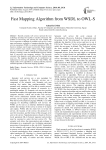
Fast Mapping Algorithm from WSDL to OWL-S
Статья научная
Recently semantic web services represent the most technology developed for machine to machine interaction. The problem of discovering and selecting the most suitable web service represents a challenge for semantic web services. In this paper performance evaluation of mapping algorithm from web services annotations (WSDL) to semantic annotations (OWL-S) based on ontology search engine is presented. During mapping process primitive type remains without change. The complex type are converted to OWL ontology by extracted them and passing to ontology search and standardization process without need of conversion into temporary ontology. The keywords extracted in the linguistic search phase and are extended using word net. The mapping algorithm and its modification are implemented in Java and evaluated by 310 files WSDL. The output results of two algorithms are identical. But the proposed modified algorithm is faster than mapping algorithm.
Бесплатно
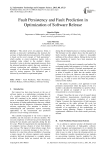
Fault Persistency and Fault Prediction in Optimization of Software Release
Статья научная
This article serves two purposes: firstly, it presents an innovative methodology that increases the accuracy of fault prediction measurements. This method is based on the novel concept of "fault persistency", which enables to correct prediction metrics with a weighted value related to the module’s history. Secondly, it aims to develop operational processes from the aforesaid prediction metrics that may contribute to software construction and validation. It presents an example of an allocation methodology for resources used for testing purposes. The theoretical part is followed by an extensive experimental phase.
Бесплатно
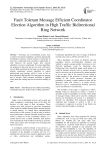
Статья научная
Nowadays use of distributed systems such as internet and cloud computing is growing dramatically. Coordinator existence in these systems is crucial due to processes coordinating and consistency requirement as well. However the growth makes their election algorithm even more complicated. Too many algorithms are proposed in this area but the two most well known one are Bully and Ring. In this paper we propose a fault tolerant coordinator election algorithm in typical bidirectional ring topology which is twice as fast as Ring algorithm although far fewer messages are passing due to election. Fault tolerance technique is applied which leads the waiting time for the election reaching to zero.
Бесплатно

Feature Diminution by Using Particle Swarm Optimization for Envisaging the Heart Syndrome
Статья научная
Health Ecosystem is derisory in techniques to haul out the information from the database because of the lack of effective scrutiny tool to discern concealed relationships and trends in them. By applying the data mining techniques, precious knowledge can be excerpted from the health care system. Extracted knowledge can be applied for the accurate diagnosis of disease and proper treatment. Heart disease is a group of condition affecting the structure and functions of the heart and has many root causes. Heart disease is the leading cause of death in all over the world in recent years. Researchers have developed many data mining techniques for diagnosing heart disease. This paper proposes a technique of preprocessing the data set and using Particle Swarm Optimization (PCO) algorithm for Feature Reduction. After applying the PCO, the accuracy for prediction is tested. It is observed from the experiments, a potential result of 83% accuracy in the prediction. The performance of PCO algorithm is then compared with Ant Colony Optimization (ACO) algorithm. The experimental results show that the accuracy obtained from PCO is better than ACO. The performance measures are based on Accuracy, Sensitivity and Specificity. The other measures such as Kappa statistic, Mean Absolute Error, Root Mean Squared Error, True Positive Rate are also taken for evaluation. As future direction of this paper, a hybrid technique which combines PCO with Rough Set theory is suggested.
Бесплатно

Статья научная
Feature Selection (FS) is an important process to find the minimal subset of features from the original data by removing the redundant and irrelevant features. It aims to improve the efficiency of classification algorithms. Rough set theory (RST) is one of the effective approaches to feature selection, but it uses complete search to search for all subsets of features and dependency to evaluate these subsets. However, the complete search is expensive and may not be feasible for large data due to its high cost. Therefore, meta-heuristics algorithms, especially Nature Inspired Algorithms, have been widely used to replace the reduction part in RST. This paper develops a new algorithm for Feature Selection based on hybrid Binary Cuckoo Search and rough set theory for classification on nominal datasets. The developed algorithm is evaluated on five nominal datasets from the UCI repository, against a number of similar NIAs algorithms. The results show that our algorithm achieves better FS compared to two known NIAs in a lesser number of iterations, without significantly reducing the classification accuracy.
Бесплатно

